Scandals of Classic Hollywood: The Gloria Swanson Saga, Part Two
by Anne Helen Petersen

When we left off, Gloria Swanson’s career was effectively over. She seemed a relic, a beautiful curio. I cannot imagine how much this must have pissed her off, but Swanson, for all of her conspicuous extravagance, was also a pragmatist — her career may have been in decline, but she still had three children and a fourth husband of dubious worth to consider.
So she did what any faded star should: She moved to New York and got in the patent business. But she did it in a roundabout sort of way, starting a company, punnily called “Multiprizes,” which, starting in 1938, made a mission of rescuing Jewish smarty-pantses from Europe, bringing them to America, and then working together with their patents, inventions, science experiments, etc. etc. It’s unclear how exploitative this may or may not have been, but several scientists made it out of Europe (good!) and Swanson failed to make any significant amount of money.
But Swanson was a busy woman. She had rid herself of dubious husband #4, and her first daughter had just married, so she pulled a good-ol-fashioned mid-career mom move and got invested in politics. Although, according to her memoirs, she had voted for Roosevelt, she didn’t believe that “any man, let alone a sick man” should have a third term, and thus centered her efforts on electing one Wendell Willkie, aka the most unfortunately named presidential candidate of all time.
Swanson began hosting mid-afternoon “salons,” if you could call them that, in an old theater on 14th Street in New York. She showed movies, made brief political speeches, and invited others to speak — including Ayn Rand, who, according to Swanson, “had a fascinating mind and held audiences hypnotized.” That’s one way to say ideological straightjacketing, but fine, fine, I’ll give it to you Gloria, but only because this happened pre-Atlas Shrugged.
And then, a whiff of a comeback in 1941: RKO calls Swanson up and throws $35,000 at her to co-star with Adolphe Menjou and “the young Latin” Desi Arnaz (La Swanson’s words, not mine) in Father Takes a Wife. They hire her long-time costumer (the guy responsible for the turban), a huge wardrobe budget, and make much ado about how “There’s Glamour on the Screen Again Because Gloria’s Back!”

But the release was ill-timed, corresponding with the release of bombs on Pearl Harbor and new-found austerity that wanted nothing to do with glamour on the screen. The film lost $100,000 (at that time, big money) and, as Swanson put it, “I pocketed my $35,000 and returned to cinematic oblivion.”
The next seven years were filled with various very Swanson-like activities: periodically appearing on the stage, returning to her art, sculpting busts, wearing jewelry, frowning beautifully, writing a newspaper column, and finding a fifth dubious husband named William Davey.
But in the spring of 1948, serendipity brought Swanson, one of the pioneers of the silent screen, to a nascent medium: television. A friend of Swanson’s, then a columnist at the New York Daily News, had been entrusted with transferring his column into an interview program on the paper’s new television venture, WPIX. He called Swanson up on short notice, had her come to the station, taped a brief interview, and that was apparently that. Only Swanson, with her long career in film and on the stage, had something the new medium craved: she was telegenic. She knew how to move her body within the space, she knew how to speak elegantly. She enunciated. And the camera obviously loved her — she managed to shine through the shitty transmission and even shittier sound that characterized the earliest days of television. As always, she was a presence — and presence was exactly what television, desperate to prove its worth, needed most.
A few months later, WPIX made Swanson an offer: Do a little television show! We’ll make a set that pretends to be your apartment! You’re a pioneer! You can invite guests, talk about your clothes, be fabulous, la la la whatever you want, the only people who’ll be watching are New York City early adopters of television. I’ve read the scripts from these shows, and I can’t tell you how fabulously un-television they are. Swanson, dripping in Swanson-ness, invites all sorts of the New York upper crust to come chat: opera singers, documentary filmmakers, Broadway actors, and haute couture designers. In short, if you made something that was high brow, then Swanson would have you on the show. Sponsors ranged from mink providers to high-end china sellers. It was so high-brow that when Swanson attempted a “budget glamour” section, she had to bring someone else in to talk about it. (Swanson, channeling the Dowager Countess, “what is a budget glamour?”)

Swanson, $50,000 necklace, painting of herself = Budget Glamour!
The show is notable not only because it was among the first crop of television programs, but because it was so clearly at odds with what televison would, very shortly, become.
UNCEREMONIOUS BREAK FOR TELEVISION HISTORY LESSON:
Early television had crappy quality. The screens on which it was broadcast were tiny, the sound was tinny. To be reductive, this led early television producers to a certain type of performer: someone who could bring down the house, even when that house had bad acoustics and you were sitting in the cheap seats. In short: vaudeville performers, dubbed “vaudeo” stars as they made their way to television. These vaudeo stars (Milton Berle, Jimmy Durante), were joined by adaptations of established radio programming (Amos & Andy) and other forms of clearly legible humor. In the very early days, this humor could even be “ethnically” based — such as the famous Goldbergs — but only because the early television audience was limited to the reception area of large urban areas. In other words, a Jewish-humor show was a viable option simply because urban Jews made up a large percentage of the overall television audience. (This sort of targeted-demo programming wouldn’t return until, oh, the ’90s and the spread of extended cable.)
As broadcasting expanded its reach, all of this started to change: farewell, Momma Goldberg; farewell, emotive Vaudeo stars; farewell, super overt racism on Amos & Andy. In their place: lots of sitcoms, Westerns, and an overall understanding of television as a medium characterized by intimacy (Hi there, viewer, I’m right here in your living room!) and relatability — the very antithesis of Hollywood.
And, importantly, the very antithesis of Gloria Swanson. The fact that even one season of The Gloria Swanson Hour got out the door is a testament to how Wild West things were in the earliest days of television. The very bedrock of this woman’s image was glamour. She was never intimate; if you took anything from the previous post, it was that she was nothing like us. But for viewers rich enough to buy an early-model television (and close enough to New York to pick up the WPIX signal), it kinda, maybe, sorta worked.
I’m not saying she got huge ratings. I’m not even saying the show was renewed, or that even your grandmother could recall its existence. I am saying, however, that I would pay a lot of money to see fuzzy footage of Swanson literally handing over the show to someone else when it came time to discuss budget glamour. That was Swanson’s image, at least at that time, perfectly encapsulated: trying to do new things, but paralyzed by the constraints of her preexisting image.
But as negotiations for Season 2 of The Gloria Swanson Hour broke down, Swanson had other plans. According to her memoir, she couldn’t agree to a contract with WPIX — she was overworked and underpaid, and they were just way too low-rent; she was constantly re-writing everything, since La Swanson obviously couldn’t stand for low standards. But it also seems clear that she had another offer waiting for her. Specifically, an offer for a comeback … which would not be a rehashing of her former image, but a straight-faced satire.
During her tenure in the ’20s, Swanson had arguably been the biggest star in the world. But this role — this would be the role of a lifetime. It was the role of Norma Desmond, a washed-up, forgotten, delusional yet perfectly preserved artifact of the silent era, trying to revive her career in post-war Hollywood. It could have been Swanson’s alternate life, and that was exactly the point: in 1950, most of the viewers would have a keen memory of 1920s Hollywood, the same way that we have a keen memory of 1980s film and television.
Which is to say that when the screenwriter (Charles Brackett) and director (Billy Wilder) were seeking someone to play the role of an iconic, desperate star to seduce an equally desperate, naive screenwriter, they immediately thought of the most classic, the most iconic of female stars. Brackett insisted that Swanson was their first choice, but Wilder has a different tale: They’d either thought of, offered the role to, and/or been flat-out rejected by Mae West, Pola Negri, Norma Shearer, Greta Garbo, and Mary Pickford.
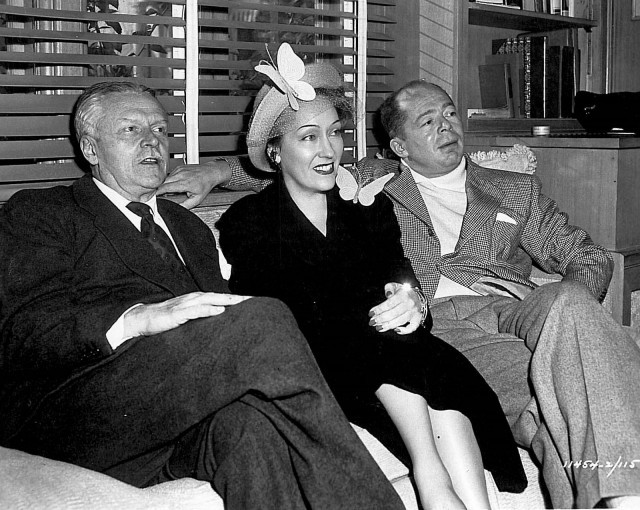
Brackett, Swanson, Swanson’s obtrusive butterflies, Wilder.
I’m sure that Swanson would’ve liked to have been the first one they thought of for it — or would she? Wasn’t it sort of a backhanded insult to be the first actress to come to mind when you think of a decaying silent star? Either way, this was something rare: a role that would succeed precisely because of Swanson’s past image, but would also allow Swanson to leave that image behind. Tom Cruise (sorta) did it with Tropic Thunder, but it’s a rarified turn. How can you simultaneously reify and transcend your image?
Does this make sense? No? Obviously you haven’t seen Sunset Boulevard. Stop typing, stop listening to your podcast, stop mailmerging, stop gchatting, stop looking at cats on Buzzfeed and watch Sunset Boulevard. No seriously, this column will be waiting for you when you get back. Sometimes I encourage you to watch a movie in order to better make sense of the subject of the piece, but this time I insist: to understand La Swanson, and what she meant and continues to mean, you must see this film.
PLUS: helllllllo, William Holden.
But just in case you’re lazy and don’t actually care about the most important role of the 1950s, no big, you just hate culture, and here’s the half-recap:
Prelude: Corpse floating, facedown, in a pool. Flashback to:
1) Joe (William Holden) is flailing as a screenwriter, desperate for work. His last attempt at a screenplay is rejected by an uppity female script-reader, who essentially calls him a hack. If that wasn’t already the worst, Holden’s late on his car payments, and the car payment collection guys are on his tail.
2) Joe takes repo goons on a chase through the Hollywood hills, blows a tire on Sunset Boulevard, and turns into the drive of an old, Miss Havisham-esque mansion, where he hides the car in the open garage.
3) The owner of the house was expecting an undertaker to take care of a dead monkey, so naturally Joe is mistaken for said undertaker. He comes inside, his eyes reflecting an increasing freak-out-ness, and figures out that the owner of the house is one Norma Desmond (Swanson) — one of the biggest stars of the silent era, but, by that point, long-forgotten, a vestige of a former age.
4) Joe (to paraphrase): “Okay okay, I’m no monkey undertaker, although maybe that should be my first sign that this shit is cray. Actually, I’m a writer.” Desmond: “Excellent! Take a look at my 5,000 page script for Salome!”
5) Joe wades through the script, realizes it’s crap, but also realizes that he could easily get paid to turn it into slightly less crap. But Norma is way ahead of him: He’s already been moved into the upstairs bedroom. Totally not creepy!
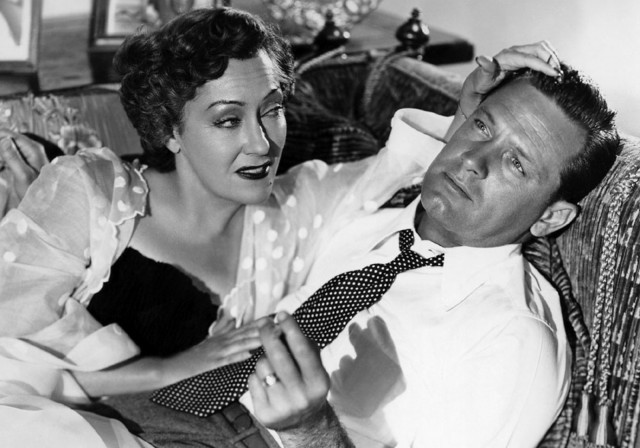
How about you just start sleeping in my bed too, Joe?
6) Joe becomes a kept man. Norma pays for everything: his back rent, exquisite clothes. But she’s living in a myth, convinced her fame endures, unable to hear reason — and the myth is sustained by her butler, who, we learn, not only sends her the fan mail that convince her of her sustained stardom, but used to be her husband (!!!).
I’m going to stop there, because all that happens next is just too good to be revealed — plus, it’s a noir, which means that the most exquisite cinematic pleasures are derived from figuring out how the action will arrive at that first shot before the flashback. The secondary pleasures are extra-textual: viewers reveled in conflation of Desmond’s past with Swanson’s own (remember, most audience members in 1950 would have a keen memory of Swanson and the silent era she embodied; for us, it’d be like watching a movie about a fallen ’80s pop star, starring Michael Jackson).
Swanson also agreed to accentuate the similarities, adding items of her personal collection to the set and costume design, performing a Chaplin imitation she made famous in Manhandled, and agreeing to the casting of her former director, Cecil B. DeMille, as, you guessed it, her former director.
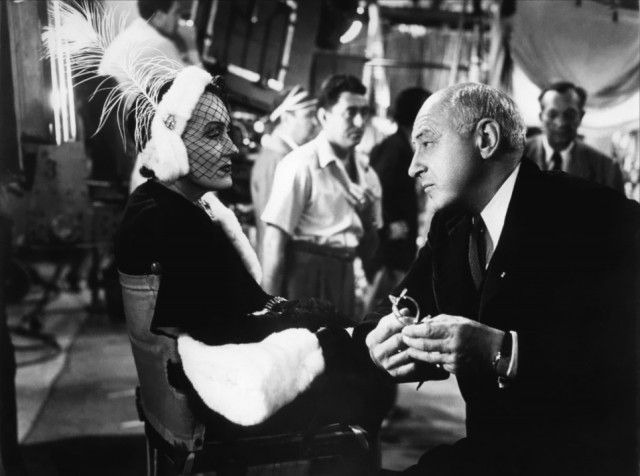
Desmond greets DeMille.
Three former silent stars (including Buster Keaton) play the “Waxworks” — a group of old friends who come to play cards with Desmond every week.
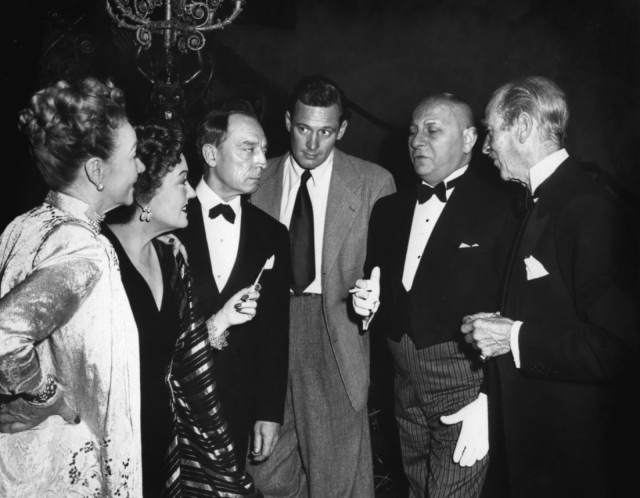
Swanson on-set with The Waxworks, Von Stroheim, and Holden.
Most deliciously, Erich Von Stroheim (the same Von Stroheim who mangled Queen Kelly) plays her butler. At one point, Joe and Norma even screen clips from Kelly — the first time they had been publicly screened in the states.

Doesn’t that sound awesome? And if you’ve seen it, doesn’t it make you want to see it again? The answer is always yes.
Some films that we now think of “classics” were middling hits when they first came out, if not outright bombs. Bringing Up Baby, The Searchers, the list goes on. But Sunset Boulevard was an immediate, smash hit — in part because it’s straight-up awesome, in part because the Hollywood publicity machine loves a self-referential film.
And Swanson’s glorious comeback, that was a story. She was nominated for Best Actress (so was Bette Davis for All About Eve; both lost to Judy Holliday in Born Yesterday, further testament to the fact that we inhabit a universe without logic) and the press filled with profiles of “Glamorous Grandmother Gloria.” At this point, Swanson was 50 years old, immaculately preserved, and nothing like her Desmond doppelgänger: She was articulate, alert, and quick to emphasize how and why she looked so good.
The answer: water. Lots of water. Little sugar, no meat. Plus steamed vegetables, all the steamed vegetables, which she brought to press events in little plastic tupperwares. She was living like a dirty yuppie hippy, 50 years ahead of her time. Whatever, it worked, because lady was a svelte, stylish fox:

Kinda makes me want to throw out the contents of my fridge, but pickles and sausage are essentially my lifeblood.
Swanson was also working very, very hard to counter the myth that made Boulevard work: She emphasized that she was nothing like Norma Desmond; all the two shared was a common past in the silent pictures. Swanson had lived a full, nondelusional life — and chided anyone who attempted to draw parallels between her and her comeback character. Of course, this is always a sticky point: Swanson was back in the limelight because of this character. Desmond was her payday, as it were. But she was also savvy to how the myth of Desmond could swallow up the facts of her own career — and the genuine pragmatism with which she had approached her life after Hollywood.
Swanson was the hottest ticket in town, and was flooded with offers in the months after Boulevard’s release. The problem, however, was that all those offers were to play slightly crazed, slightly washed-up aging actresses. Wary of being typecast — or further conflating her image with Norma’s — she passed on dozens of offers. Realizing that she was losing whatever momentum remained, though, she agreed to star as a fading actress in Three for Bedroom “C” (1952), but only because it was a comedy and un-Desmond-esque. But the film fell flat, and Swanson, frustrated all over again with Hollywood, turned to a lifelong passion: fashion design.
Swanson had, in her words, “never publicized the fact that for years I had designed most of my clothes or at least worked hand in glove with the recognized designers I trust in the business, such as Edith Head and Rene Hubert.”
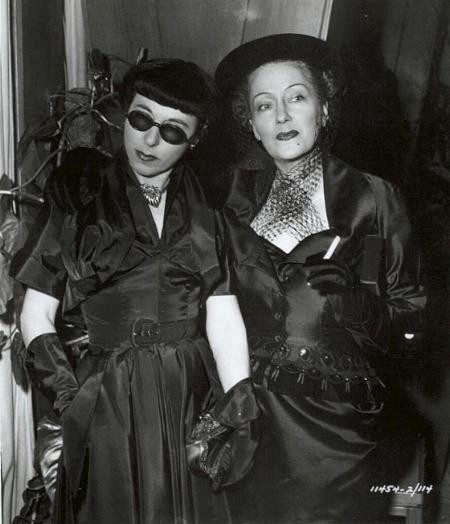
La Swanson and Edith, First Generation Swag.
So when Neiman Marcus decided to give her a “Distinguished Service in the Field of Fashion” award, she naturally designed a week’s worth of clothes for the occasion. (One of her favorite designs: the triple-cloche, in which you just put three cloches on top of each other and wear. La Swanson!) Someone asked about something she was wearing, and when it was revealed that she had designed the outfit herself, one thing lead to another, and suddenly she was having a conversation with the owner of Puritan Fashions, who offered her a job designing her own line. But this was no haute couture line: it was “Gloria Swanson Originals by Forever Young,” heavy on the sensible (read: postwar, washable fabrics like nylon and rayon) and intended for older, plumper women. In other words, it was like classy Chico’s.


Swanson would go to Paris during fashion week, see the shows, probably buy the expensive, size-0 stuff for herself, and make some sketches, and come home to turn those ideas into dresses for the masses. Every year, she made a massive tour of the United States, appearing at department stores, fashion shows, and lady luncheons from Dayton, Ohio, to Spokane, Washington. Lady worked it.
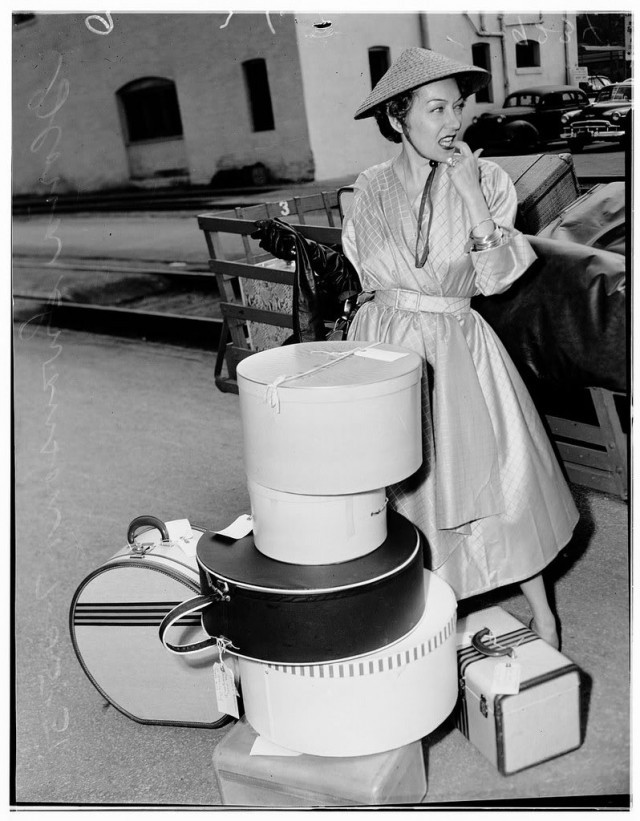
No such thing as too many hat boxes.
Copy for the ads, fashion shows, and other promotional materials made a huge deal about how the purchase of a dress brought the wearer their own bit of glamour: Put on the dress, and Gloria’s glamour can be yours! Now, forgive me a moment of academic wonkery, but this idea — that glamour was something that even you filthy masses could have — was a huge shift. During the silent era, stars like Swanson and Garbo were figured as goddesses: As I’ve said many times before, they were constructed as nothing “like us.” With the coming of sound and the spread of the Depression, this conception changed. Stars were at once ordinary and extraordinary; cleaning the house and dripping with diamonds. During World War II, suddenly everything was about sacrifice: Dresses that required conservative amounts of fabric were in; unseemly opulence was out.
But post-war, something fascinating happened: You had a culture fixated on consumption — specifically consumption linked to the home. You had the spread of cheaper, highly wearable fabrics that didn’t need special cleaning or meticulous ironing. You had a whole new brand of television star (not like Swanson’s television — we’re talking national, mainstream television, which really got going around 1952) that mixed the intimate and the accessible … and was quite literally smaller than life. But then you had Dior’s New Look, which took the fashion world by storm in 1947, characterized by super-indulgent use of fabrics (yards and yards!) and feminine silhouettes. Postwar glamour somehow encompassed all of those trends. It was practical yet impractical, feminine and, most importantly, accessible, like the television star, to all. In this way, the connotation and conception of glamour changed significantly — it was neither innate nor limited by class or culture. Rather, it was achievable for all — especially if you had $14.99 for a Swanson Original.
Ad copy and fashion show script mirrored this conception, encouraging audience members to “HITCH YOUR GLAMOUR TO A STAR!” Or, in one of my favorite moves, they rebranded what we would now call Plus Sizes as “Glamour Sizes.” Genius! LA SWANSON!
Now, you might think I’m going a little crazy on the dress theorization, and trust me, when I first started talking about this stuff in a graduate seminar, the hetero mansplaining dudes in the room gave me that look that can only be described as pitying. (That poor girl, so distracted by material culture!) I mean, the dresses are no Sunset Boulevard, but they arguably contributed as much to Swanson’s enduring image over the 20+ years she partnered with Puritan. It’s like trying to talk about the image of Michael Jordan without talking about Nike, or about Jessica Simpson without talking about heels. It cannot — or at least should not — be done. Plus, you can buy some RIGHT NOW on eBay. My favorites are here and here (that one EVEN HAS THE TAGS WITH HER FACE ON THEM; totally amazing).

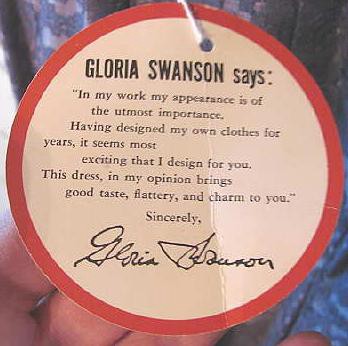
For the next 30 years, Swanson divided her time among dress promotion, appearing on television shows looking fabulous, telling everyone she knew about the evils of sugar, and doing yoga in pantsuits.
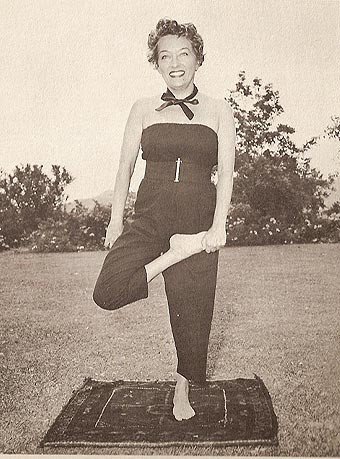
Her interview on The Dick Cavett Show — with Janis Joplin across from her on the couch — must be seen to be believed.
I don’t even know where to begin. The wig? The headband? The way she enters clutching A RED ROSE? The laugh? When she looks over at Joplin and says “How do you do?” WHEN JOPLIN CALLS HER A SILVER-TONGUED DEVIL? Oh wait, maybe it’s when Cavett thanks her for the sculpture she did of him, and Swanson responds “I want to do his head,” looks over at Joplin, and asks “do you know what I mean by that?”
Just look at her skin — this was filmed in 1970, which would have made her 71 years old. Bitch please, that is amazing.
There was a catty, self-satirizing appearance in Airport 1975, a nationwide tour to promote soon-to-be-sixth-husband William Dufty’s book, Sugar Blues, and countless interviews and quips. There was also a little fight with Kenneth Anger over the things he said about her in Hollywood Babylon — a fight that prompted a stream of what can only be called “hate art” — but that’s a mind-bending, macabre story I’m working on turning into something long and juicy, so I’ll have to annoyingly leave it at that.
Point is, Swanson was a vibrant part of the American imaginary for decades, and in a way that so many of her contemporaries never were. Whether those stars were shy, ashamed, sick of the limelight, or just didn’t have to support their family the way Swanson did, it seems clear that Swanson’s image, at least for the second half of the story, was always a product of her own machinations. She controlled her own narrative, making herself interesting to a nation that seldom finds women over 50 worth consideration.
At age 81, she reenergized that image with one final, triumphant push, publishing her memoirs, amazingly titled Swanson on Swanson. Now, the star memoir is, generally speaking, pretty impoverished literary-wise. Somehow, most stars make the story of their lives boring, a truly remarkable feat. But Swanson not only revealed the details of her affair with Kennedy (long disavowed), but spoke clearly and without pretense. It’s juicy, it’s no-nonsense, it makes her seem like a real, complicated, self-confident woman. As Janet Maslin put it in her review for the Times, “Whatever else she may have been, Miss Swanson was never confused.”
If you’ve been reading this column for a while, you know how 99% of the stories of classic female stars have ended: in suicide, in overdose, in mental illness, in seclusion. The ideological weight of stardom was, quite simply, too much to bear. Stardom broke these women — not because they were weak, but because it was such a strong, contradictory, fiercely demanding mistress.
It’s difficult to say what, exactly, Swanson did differently to inoculate herself from that fate. I’d probably trace it to the ’20s, when she not only found the gumption to divorce an abusive husband, but also decided she was going to turn down piles of money for the opportunity to produce her own films. Few stars, male or female, have understood that creative control could ultimately be more fulfilling — and ultimately more powerful — than salary. Swanson had had the huge salary. She’d basically bought everything there was to be bought. And she still found it wanting. At that point, you can either turn into a Citizen Kane-like ball of aimless, soulless despair, or you can figure out that conspicuous consumption can only provide so many pleasures.
In other words, Swanson could very well have been a Norma Desmond — that, of course, is the hook of Sunset Boulevard. But instead of receding, however monied, into the rear view of American culture, she took risks, produced her own films, went big and refused to go home. When it seemed her time had passed, she moved to New York and made a new life for herself, cultivating new passions: new hobbies, new husbands, new ways of wearing old clothes. She was a sculptress, a food and exercise nut way before it was cool, a mother, an inventor, a designer, a political advocate. She gradually became one of those Grandmas who somehow does everything, loves everything, and always looks so put-together doing it.

Swanson in the ruins of the Roxy Theater, where her first production, ‘The Love of Sunya,’ premiered in 1927.
In 1950, when a reporter asked Swanson why she spent so much money on dresses, she replied “without it I’m not Gloria Swanson. It’s a business expense.” In the same interview, she asserted “When I die, my epitaph should read: ‘She paid all the bills.’” For Swanson was, first and foremost, a businesswoman, with a keen appreciation of how her image could sustain her family for decades — but only if she tended to it carefully. She understood this when she accepted the role of Norma Desmond, and she understood this when she refused to play that role over and over again, until she became a shade of a shade. She understood it when she toured the country promoting her dress line, and she understood it when she accepted a million dollars to write her 500-page memoirs.
She even understood it when she donated her papers — 78 boxes and four file cabinets’ worth — to the Harry Ransom Center at the University of Texas, where people like me, who didn’t even realize they were interested in Gloria Swanson, could explore the traces of her public and private life, and conclude, as I did, that she might have lived the fullest life of all the Hollywood stars. She could be a bit snobbish, she could be a bit didactic. She would probably come into your kitchen right now and throw out all your food, tell you to go drink a gallon of water, then make you take off your dress so she could tailor it. But she was also seriously funny, with an acerbic, enviable wit. In every picture I see of her, no matter her age, she looks so alive, so fiercely present. She was a force to behold, and the author of her own life. And that, as I hope you’ve come to agree, is a story I just can’t stop reading.
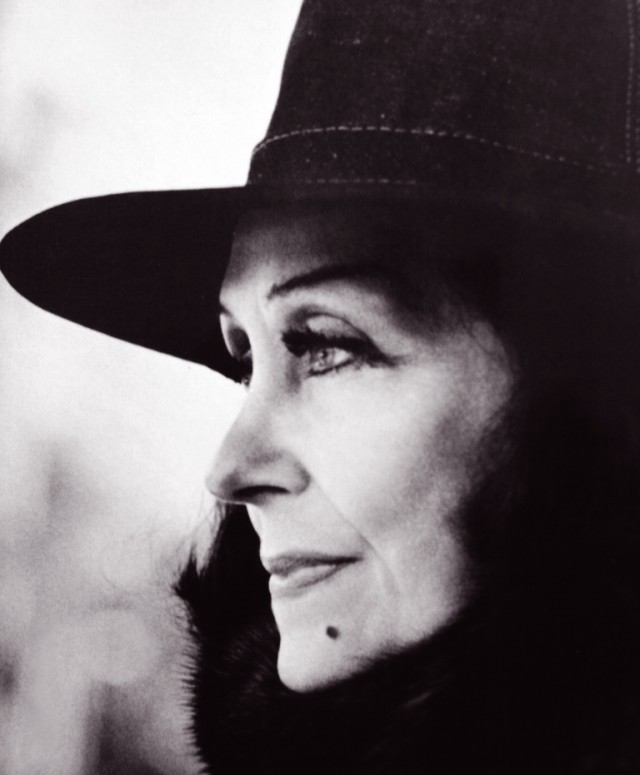
Previously: Part One.
Anne Helen Petersen is a Doctor of Celebrity Gossip. No, really. You can find evidence (and other writings) here.